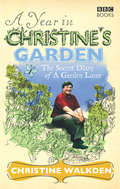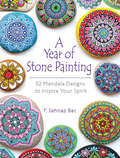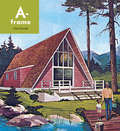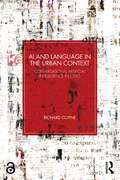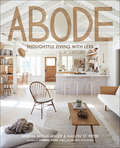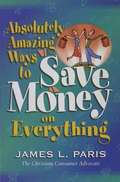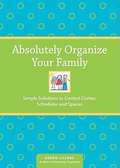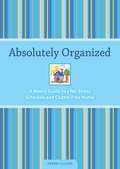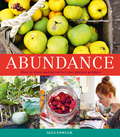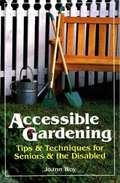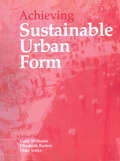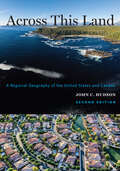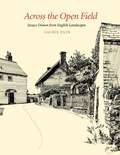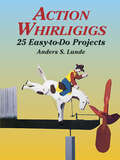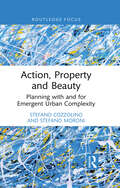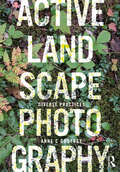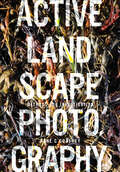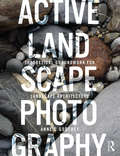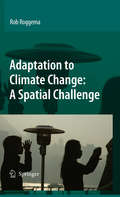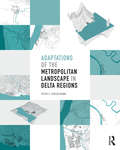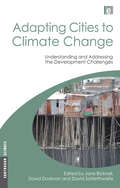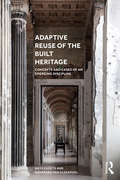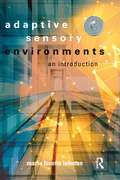- Table View
- List View
A Year in Christine's Garden
by Christine WalkdenA Year in Christine's Garden is the utterly down-to-earth account of one woman's passion for plants. Recounting stories from her hectic life in horticulture, Christine Walkden's diary is a heartwarming account of octogenarian neighbours, living with a film crew and helping friends with their gardening needs. Reflecting all the charm of her BBC2 television series, Christine's narrative paints a picture of the day-to-day beauty that surrounds her. She likes being outside, she likes walking her dog Tara, she likes watching the light change and she enjoys those little moments when everything seems right in the world.With irrepressible enthusiasm, she interweaves tips and advice to prove that the best gardens are approachable and achievable. Forget fashion, forget trends - Christine's garden is about no-nonsense planting and growing what you enjoy. As the year progresses, this warm, but frank diary brings to life all the moments of pride, excitement, relaxation and laugh-out-loud fun that make Christine's garden a haven of contentment.
A Year of Stone Painting: 52 Mandala Designs to Inspire Your Spirit
by F Sehnaz BacYou can craft a new mandala every week for one year with this full-color guide by the author of the bestselling The Art of Stone Painting. F. Sehnaz Bac, an artist and seasoned archaeologist, presents step-by-step instructions for fifty-two projects. Her easy-to-follow guide will show you how to transform ordinary stones into inspirational works of art. The mandala — derived from the Sanskrit word for "circle" — represents the universe, and the symbol has long been instrumental to sacred rituals and meditative practices. This treasury of radiant designs presents patterns for stone paintings, each of which is accompanied by a one-word mantra — relax, tranquil, spirit, dream, believe, and other uplifting terms. A few projects are meant to be painted on sea glass, leaves, or shells, but most are based on Bac's popular interpretations of classic stone-based styles. Colorful photographs accompany simple instructions for a year of crafting inspiration.
A-Frame: Revised Edition
by Chad RandlThe heyday of the national A-frame craze saw tens of thousands of these easy and affordable structures built as vacation homes, roadside restaurants, churches, and even pet stores. A-frame chronicles America's love affair with the A-frame, from postwar getaway to its recent revival among designers and DIYers. In a fascinating look at this architectural phenomenon, Chad Randl tells the story of the triangle house, from prehistoric Japan to its lifestyle-changing prime in the 1960s as a symbol of play, leisure, and outdoor living. Part architectural history and part cultural exploration, the book documents every aspect of A-frame living with cartoons, ads, high-style and do-it-yourself examples, family snapshots, and an appendix with a complete set of blueprints in case you want to build your own.
AI and Language in the Urban Context: Conversational Artificial Intelligence in Cities
by Richard CoyneIn a world influenced increasingly by artificial intelligence (AI), the city emerges as a dynamic hub of digital conversations. AI and Language in the Urban Context offers a novel exploration of how AI, particularly large language models (LLMs), is transforming urban environments. Moving beyond the typical technological narratives, this book draws on the author’s unique expertise in design, semiotics and hermeneutics to present a critical cultural perspective on AI’s role in the city.Focusing on the intersection of urban theory and AI, the book reveals how conversational AI is reshaping social interactions, decision-making processes, and media in urban spaces. By merging practical knowledge of AI algorithms with an understanding of urban practices, the author highlights the opportunities and challenges AI presents for modern cities.This book is essential for anyone interested in the future of urban living. It provides a deep dive into the technical, social and cultural implications of AI in cities, offering practical examples and philosophical insights. Readers will gain a comprehensive understanding of how AI is influencing the design, governance and dynamics of urban life in the digital age.The Open Access version of this book, available at www.taylorfrancis.com, has been made available under a Creative Commons [Attribution-Non Commercial-No Derivatives (CC-BY-NC-ND) 4.0 license.
Abode: Thoughtful Living with Less
by Serena Mitnik-Miller Mason St. Peter Melissa GoldsteinCreate your space with simplicity, tranquility, and beautifully minimalist style.The yearning for a life of pared-down purity has built to a roar, and Serena Mitnik-Miller and Mason St. Peter—the husband-and-wife owners of General Store, one of California’s most talked-about shops—are at the forefront. In Abode: Thoughtful Living with Less, these tastemakers make a graceful case for living better no matter your budget or abilities, guiding you to create a space this is simple and true. Their time-tested methods create interiors that maximize openness, strip a building back to its bones, and amplify natural light, evoking unpretentious tranquility. The blueprint for their signature aesthetic is all here: the embrace of elemental materials, curation of handcrafted objects, and collection of furnishings from eras when craftsmanship was king. This selection of Mitnik-Miller and St. Peter’s greatest collaborations will take you through their breathtaking rooms, masterpieces of warm minimalism. Abode is a glimpse into the couple’s process and a guide to manifesting your own beautiful interiors.
Absolutely Amazing Ways to Save Money on Everything
by James ParisTips on saving money on dining out, health care, home repair and much more.
Absolutely Organize Your Family
by Debbie LillardStruggle Less and Savor More Managing a family is no easy task. There are school projects to supervise, a constant deluge of laundry and toys to deal with, and after-school activities to drive to every night. It makes you wish you had an instruction manual to help you keep it all together-well, now you do! Absolutely Organize Your Familyis full of practical and effective solutions for all of your family's organizational challenges. Debbie Lillard, professional organizer, mother of three and author of the popular bookAbsolutely Organized, offers all new "Absolutes of Organizing Your Family" tips to help you gain and maintain order in three key areas of your family life: Schedules, belongings and spaces. Inside you'll find: Solutions for overcrowded and out-of-control schedules Advice on establishing morning, evening, and bedtime routines Strategies for organizing toys, collections, artwork, photographs, and more Ways to keep closets and dressers in order even in the midst of growth spurts Help for your child's schoolbag, desk, and locker Methods of keeping bedrooms organized Ideas for creating a homework area to improve study habits. Spend less time struggling to keep up and more time savoring everyday moments with your family. Start your family's organizational makeover today.
Absolutely Organize Your Family
by Debbie LillardStruggle Less and Savor More Managing a family is no easy task. There are school projects to supervise, a constant deluge of laundry and toys to deal with, and after-school activities to drive to every night. It makes you wish you had an instruction manual to help you keep it all together-well, now you do! Absolutely Organize Your Family is full of practical and effective solutions for all of your family's organizational challenges. Debbie Lillard, professional organizer, mother of three and author of the popular book Absolutely Organized, offers all new "Absolutes of Organizing Your Family" tips to help you gain and maintain order in three key areas of your family life: Schedules, belongings and spaces. Inside you'll find: Solutions for overcrowded and out-of-control schedules Advice on establishing morning, evening, and bedtime routines Strategies for organizing toys, collections, artwork, photographs, and more Ways to keep closets and dressers in order even in the midst of growth spurts Help for your child's schoolbag, desk, and locker Methods of keeping bedrooms organized Ideas for creating a homework area to improve study habits. Spend less time struggling to keep up and more time savoring everyday moments with your family. Start your family's organizational makeover today.
Absolutely Organized
by Debbie LillardDo you run non-stop but never feel like you accomplish anything? Feel stressed out at home? Dream about doing things that you never get around to doing? Wish you had extra hours in your day? Well, here's something even better!Absolutely Organized is "a book full of tips and hope" for overworked, time-crunched, clutter-crushed moms. It's brimming with practical, proven and, in many cases, very simple solutions for keeping order in every corner of your life, from your refrigerator to your file drawers, from keeping a newborn on a set schedule to getting kids to willingly pitch in on household chores.Debbie Lillard, professional organizer and mother of three, shares her easy-to-use "Absolutes of Organizing" tips to help you gain and maintain order in the three key areas of your family's life:YOUR TIME: Learn the tricks for streamlining cleaning, laundry, grocery shopping and other everyday duties. Get more done and have more time left over to spend on your kids, your spouse, projects around the house, and even yourself!YOUR BELONGINGS: Use Debbie's simple but effective C.P.R. method (Categorize, Purge and Rearrange) to organize paperwork, photos, collections, toys, clothes, children's artwork and more.YOUR HOME: Take it room by room—home office, kitchen, bathroom, family room and even (gulp!) the kids' rooms. Rid your house of clutter, make the most of your space, and make home feel more comfortable, functional and relaxing.Follow Absolutely Organized from start to finish for a complete, full-life makeover. Or dip in here and there for help on one problem area at a time, such as that ever-growing mountain of paperwork, your collection of children's memorabilia, or that disaster area called a closet. Tried-and-true advice for every mom, Absolutely Organized will help you simplify your life so you can enjoy more and stress less.
Absolutely Organized: A Mom's Guide to a No-Stress Schedule and Clutter-Free Home
by Debbie LillardDo you run non-stop but never feel like you accomplish anything? Feel stressed out at home? Dream about doing things that you never get around to doing? Wish you had extra hours in your day? Well, here's something even better! Absolutely Organized is a book full of tips and hope for overworked, time-crunched, clutter-crushed moms. It's brimming with practical, proven and, in many cases, very simple solutions for keeping order in every corner of your life, from your refrigerator to your file drawers, from keeping a newborn on a set schedule to getting kids to willingly pitch in on household chores. Debbie Lillard, professional organizer and mother of three, shares her easy-to-use Absolutes of Organizing tips to help you gain and maintain order in the three key areas of your family's life: YOUR TIME: Learn the tricks for streamlining cleaning, laundry, grocery shopping and other everyday duties. Get more done and have more time left over to spend on your kids, your spouse, projects around the house, and even yourself! YOUR BELONGINGS: Use Debbie's simple but effective C. P. R. method (Categorize, Purge and Rearrange) to organize paperwork, photos, collections, toys, clothes, children's artwork and more. YOUR HOME: Take it room by room-home office, kitchen, bathroom, family room and even (gulp!) the kids' rooms. Rid your house of clutter, make the most of your space, and make home feel more comfortable, functional and relaxing. Follow Absolutely Organized from start to finish for a complete, full-life makeover. Or dip in here and there for help on one problem area at a time, such as that ever-growing mountain of paperwork, your collection of children's memorabilia, or that disaster area called a closet. Tried-and-true advice for every mom, Absolutely Organized will help you simplify your life so you can enjoy more and stress less.
Abundance: How to Store and Preserve Your Garden Produce
by Alys FowlerFresh produce is a joy: crunchy lettuce, sun-warmed tomatoes, juicy berries - their flavours are immediate - but a winter of those summer flavours preserved, now that's a feeling of satisfaction. If you are going to truly try and attain a little more self-sufficiency (and save some money at the same time), think about what you can store to get you through the leaner months. Alys takes you through all the different ways of preserving - bottling, drying, fermenting, freezing, pickling, using sugar - with delicious recipes that make the most of your produce. This book is a must for anyone who wants to store and preserve their garden bounty.
Accessible Gardening: Tips And Techniques For Seniors And The Disabled
by Joann WoyIf advancing age, illness, or accident has made gardening too difficult for you, don't become frustrated. There is an alternative. Accessible Gardening is a book of tips and techniques that will help you to overcome obstacles and return the joy of gardening to your life: recommendations for modifying an existing garden for gardening ease; advice on selecting ergonomic tools and low-maintenance plants; directions for constructing raised-bed planters; instructions for developing manageable watering and pest-control systems; specifications for paths, inclines, and railings; discussion on the psychological and physical benefits of gardening.
Achieving Sustainable Urban Form
by Katie Williams Mike Jenks Elizabeth BurtonAchieving Sustainable Urban Form represents a major advance in the sustainable development debate. It presents research which defines elements of sustainable urban form - density, size, configuration, detailed design and quality - from macro to micro scale. Case studies from Europe, the USA and Australia are used to illustrate good practice within the fields of planning, urban design and architecture.
Across This Land: A Regional Geography of the United States and Canada (Creating the North American Landscape)
by John C. HudsonA fascinating overview of the lands and peoples of the United States and Canada, both past and present.Based on decades of research and written in clear, concise prose by one of the foremost geographers in North America, John C. Hudson's Across This Land is a comprehensive regional geography of the North American continent. Dividing the terrain into ten regions, which are then subdivided into twenty-seven smaller areas, Hudson's brisk narrative reveals the dynamic processes of each area's distinctive place-specific characteristics. Focusing on how human activities have shaped and have been shaped by the natural environment, Hudson considers physical, political, and historical geography. He also highlights related topics, including resource exploitation, economic development, and population change. Praised in its first edition as a readable and reliable interpretation of United States and Canadian geography, the revised Across This Land retains these strengths while adding substantial new material. Incorporating the latest available population and economic data, this thoroughly updated edition includes• reflections on new developments, such as resource schemes, Native governments in Atlantic Canada, and the role of climate change in the Arctic• a new section focused on the US Pacific insular territories west of Hawaii• evolving views of oil and gas production resulting from the introduction of hydraulic fracturing• revised text and maps involving agricultural production based on the 2017 Census of Agriculture• current place names• more than 130 photographsThe most extensive regional geography of the North American continent on the market, Hudson's Across This Land will continue as the standard text in geography courses dealing with Canada and the United States, as well as a popular reference work for scholars, students, and lay readers.
Across the Open Field
by Laurie Olin"Twenty-eight years ago I went to England for a three-month visit and rest. What I found changed my life."So begins this memoir by one of America's best-known landscape architects, Laurie Olin. Raised in a frontier town in Alaska, trained in Seattle and New York, Olin found himself dissatisfied with his job as an urban architect and accepted an invitation to England to take a respite from work. What he found, in abundance, was the serendipity of a human environment built over time to respond to the land's own character and to the people who lived and worked there. For Olin, the English countryside was a palimpsest of the most eloquent and moving sort, yet whose manifestation was of ordinary buildings meant to shelter their inhabitants and further their work.With evocative language and exquisite line drawings, the author takes us back to his introduction to the scenes of English country towns, their ancient universities, meandering waterways, and dramatic cloudscapes racing in from the Atlantic. He limns the geologic histories found within the rock, the near-forgotten histories of place-names, and the recent histories of train lines and auto routes. Comparing the growth of building in the English countryside, Olin draws some sobering conclusions about our modern lifestyle and its increasing separation from the landscape.As much a plea for saving the modern American landscape as it is a passionate exploration of what makes the English landscape so characteristically English, Across the Open Field is "an affectionate ramble through real places of lasting worth."
Action Whirligigs: 25 Easy-to-Do Projects
by Anders S. LundeWhirligigs -- those charming little wind-driven toys -- make excellent introductory woodworking projects because they are easy to do, inexpensive and -- most of all -- great fun! Hobbyists at all levels of ability will love creating the 25 delightful projects described in this book, from the simple Baking a Pie whirligig to the double-armed Woman at the Computer. Other figures include a Man/Woman Fishing, Oil Well Pump, Saluting the Flag, See-Saw, and Bucking Bronco. Easy-to-follow instructions and measured drawings explain everything from selecting and using proper tools and creating the driving mechanism to finishing and displaying the completed project.
Action, Property and Beauty: Planning with and for Emergent Urban Complexity
by Stefano Moroni Stefano CozzolinoWhat are the challenges and potential of complex and emergent urban systems? This book answers this question by shedding new light on the topics of emergence, complexity, and self-organisation and showing their interconnectedness with other concepts, such as property and beauty, which are usually considered separately. It contributes to the discussion by interpreting and explaining the nature of emergent urban phenomena and suggesting more appropriate design and planning measures.The book explores and untangles these crucial topics in a compact and accessible way by offering fresh interdisciplinary perspectives on the themes of action and interaction, self-organisation, property, neighbourhood adaptability, urban beauty, and suitable public planning and design interventions. It provides novel and crucial insights for students, researchers, and academics in Urban Studies, Planning Theory, Planning Ethics, Planning Law, Legal, Political and Human Geography, Urban and Regional Economics, Urban Sociology, and Urban Design. It is essential for anyone interested in exploring the emergent dynamics of complex urban contexts, as well as for those involved in developing various projects and measures who aim to consider the spontaneous nature of cities seriously.
Active Landscape Photography: Diverse Practices (Active Landscape Photography)
by Anne C GodfreyDiverse Practices, the third book in the Active Landscape Photography series, presents a set of unique photographic examples for site-specific investigations of landscape places. Contributed by authors across academia, practice and photography, each chapter serves as a rigorous discussion about photographic methods for the landscape and their underlying concepts. Chapters also serve as unique case studies about specific projects, places and landscape issues. Project sites include the Miller Garden, Olana, XX Miller Prize and the Philando Castile Peace Garden. Landscape places discussed include the archeological landscapes of North Peru, watery littoral zones, the remote White Pass in Alaska, Sau Paulo and New York City’s Chinatown. Photographic image-making approaches include the use of lidar, repeat photography, collage, mapping, remote image capture, portraiture, image mining of internet sources, visual impact assessment, cameraless photography, transect walking and interviewing. These diverse practices demonstrate how photography, when utilized through a set of specific critical methods, becomes a rich process for investigating the landscape. Exploring this concept in relationship to specific contemporary sties and landscape issues reveals the intricacy and subtlety that exists when photography is used actively. Practitioners, academics, students and researchers will be inspired by the underlying concepts of these examples and come away with a better understanding about how to create their own rigorous photographic practices.
Active Landscape Photography: Methods for Investigation (Active Landscape Photography)
by Anne C GodfreyHow can photography be transformed into an active process of investigation for landscape architecture and environmental design? The second book in Godfrey’s series, Active Landscape Photography, presents engaged photographic methods that turn photography into a rigorous, thoughtful endeavor for the research, planning and design of landscape places. Photography is the most ubiquitous and important form of representation in these disciplines. Yet photography is not specifically taught as a core skill within these fields. This book creates a starting point for filling this gap. Concepts and working methods from contemporary photography and critical cultural theories are contextualized into situations encountered in the daily practice of landscape architecture and environmental design. These methods can be integrated into practices in academic and professional settings or picked up and self-taught by an individual reader. Part I: Methods presents easily accessible approaches to photography creating a core set of active skills. Part II: Practices discusses working methods of specific contemporary photographers and extrapolates their practices into common extrapolates their practices into common planning and design situations. Contemporary photographers presented include Richard Misrach, Dawoud Bey, Duane Michals, Latoya Ruby Frazier, Mark Klett, Sophie Calle, Joe Deal, Robert Adams, Naima Green, Bernd and Hilla Becher, Stephen Shore, David Hockney, Amy Sherald, William Christenberry, Jeff Wall, and Sohei Nishino. Beautifully illustrated in full color with over 150 images by Godfrey, her students, and contemporary photographers, this book provides both clear guidelines for a set of diverse methods as well as a deeper discussion about the implications of making and using photography in environmental design for professionals, academics, students and researchers.
Active Landscape Photography: Theoretical Groundwork for Landscape Architecture
by Anne C GodfreyPhotographs play a hugely influential but largely unexamined role in the practice of landscape architecture and design. Through a diverse set of essays and case studies, this seminal text unpacks the complex relationship between landscape architecture and photography. It explores the influence of photographic seeing on the design process by presenting theoretical concepts from photography and cultural theory through the lens of landscape architecture practice to create a rigorous, open discussion. Beautifully illustrated in full color throughout, with over 200 images, subjects covered include the diversity of everyday photographic practices for design decision making, the perception of landscape architecture through photography, transcending the objective and subjective with photography, and deploying multiplicity in photographic representation as a means to better represent the complexity of the discipline. Rather than solving problems and providing tidy solutions to the ubiquitous relationship between photography and landscape architecture, this book aims to invigorate a wider dialogue about photography's influence on how landscapes are understood, valued and designed. Active photographic practices are presented throughout for professionals, academics, students and researchers.
Adaptation to Climate Change: A Spatial Challenge
by Rob RoggemaAs it becomes clear that climate change is not easily within the boundaries of the 1990's, society needs to be prepared and needs to anticipate future changes due to the uncertain changes in climate. So far, extensive research has been carried out on several issues including the coastal defence or shifting ecozones. However, the role spatial design and planning can play in adapting to climate change has not yet been focused on. This book illuminates the way adaptation to climate change is tackled in water management, ecology, coastal defence, the urban environment and energy. The question posed is how each sector can anticipate climate change by creating spatial designs and plans. The main message of this book is that spatial design and planning are a very useful tool in adapting to climate change. It offers an integral view on the issue, it is capable in dealing with uncertainties and it opens the way to creative and anticipative solutions. Dealing with adaptation to climate change requires a shift in mindset; from a technical rational way of thinking towards an integral proactive one. A new era in spatial design and planning looms on the horizon.
Adaptations of the Metropolitan Landscape in Delta Regions
by Peter C BosselmannAdaptations of the Metropolitan Landscape in Delta Regions is about environmental quality and the long term livability of urban areas. In decades to come, climate change will affect cities everywhere, but nowhere have the effects of climate change already been felt as strongly as in low-lying coastal cities, cities located in large river deltas and near tidal estuaries. This book reflects on the contribution that spatial planning and urban design can make to a complex discussion about how city form and landscapes will need to adapt within metropolitan areas. The book’s focus is on the urban form of three delta regions: the Pearl River Delta in Southern China; the Rhine, Maas, and Scheldt Delta in the Netherlands; and the San Francisco Bay Area in Northern California. The three regions differ greatly, but despite their different political systems, history, culture and locations in three different climate zones, all three regions will be forced to respond to similar issues that will trigger transformations and adaptations to their urban form. Richly illustrated in color with detailed diagrams, models, photographs and sketches, the book is written for students, scholars and practitioners of environmental planning, and designers who need to respond to the future form of cities in light of climate change. For the professions shaping the physical world of cities and regions, the challenge is not only one of designing physical geometries but of social consequences.
Adapting Cities to Climate Change: Understanding and Addressing the Development Challenges (Earthscan Climate Ser.)
by David Satterthwaite David Dodman Jane BicknellThis volume brings together, for the first time, a wide-ranging and detailed body of information identifying and assessing risk, vulnerability and adaptation to climate change in urban centres in low- and middle-income countries. Framed by an overview of the main possibilities and constraints for adaptation, the contributors examine the implications of climate change for cities in Africa, Asia and Latin America, and propose innovative agendas for adaptation. The book should be of interest to policy makers, practitioners and academics who face the challenge of addressing climate change vulnerability and adaptation in urban centres throughout the global South. Published with E&U and International Institute for Environment and Development
Adaptive Reuse of the Built Heritage: Concepts and Cases of an Emerging Discipline
by Bie Plevoets Koenraad Van CleempoelAdaptive reuse – the process of repairing and restoring existing buildings for new or continued use – is becoming an essential part of architectural practice. As mounting demographic, economic, and ecological challenges limit opportunities for new construction, architects increasingly focus on transforming and adapting existing buildings. This book introduces adaptive reuse as a new discipline. It provides students and professionals with the understanding and the tools they need to develop innovative and creative approaches, helping them to rethink and redesign existing buildings – a skill which is becoming more and more important. Part I outlines the history of adaptive reuse and explains the concepts and methods that lie behind new design processes and contemporary practice. Part II consists of a wide range of case studies, representing different time periods and strategies for intervention. Iconic adaptive reuse projects such as the Caixa Forum in Madrid and the Rijksmuseum in Amsterdam are discussed alongside less famous and spontaneous transformations such as the Kunsthaus Tacheles in Berlin, in addition to projects from Italy, Spain, Croatia, Belgium, Poland, and the USA. Featuring over 100 high-quality color illustrations, Adaptive Reuse of the Built Heritage is essential reading for students and professionals in architecture, interior design, heritage conservation, and urban planning.
Adaptive Sensory Environments: An Introduction
by Maria Lorena Lehman***WINNER OF A NAUTILUS 2017 SILVER MEDAL BOOK AWARD*** Adaptive Sensory Environments: An Introduction presents a cutting-edge methodology for adaptive sensory design by fostering an inter-disciplinary approach in which aspects of neuroscience, biophilia, captology, nanotechnology, kinetics, and sensemaking all play critical roles in helping adaptive architecture "tune" to occupants. Furthermore, the book illustrates how adaptive sensory environments transform and uplift quality of life in entirely new ways, by strategically unlocking the potential that technological innovations bring. By teaching scholars, researchers, practitioners, specialists, and consultants how to design architecture that guides what emerging interactive technology can do, it allows them to see deeper into an architectural design, to extend beyond interaction and, ultimately, to build environments that adapt by changing and growing with their occupants’ immediate needs and long-term goals.
